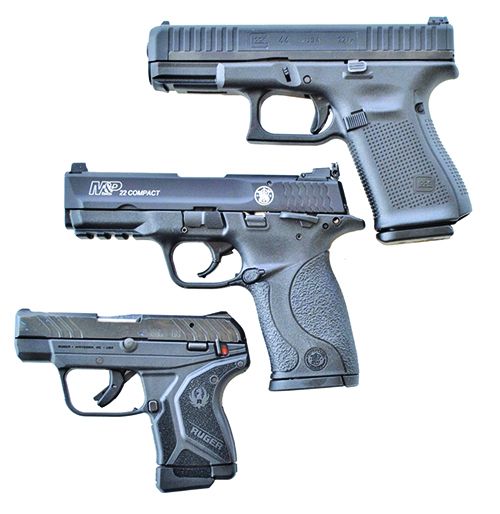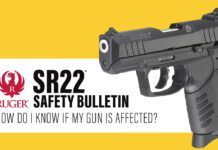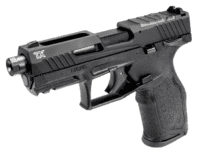Within the past few months, two major firearms makers, Glock and Ruger, introduced 22 rimfire versions of popular centerfire handguns. Already in the smallbore pistol market is the Smith & Wesson M&P22. Most 22 pistols can be great trainers if they are rimfire twins of a centerfire handgun. For instance, the Smith & Wesson M&P22 Compact has been around a few years and is basically a Shield-size 22 pistol. It isn’t difficult to design a 22-caliber pistol that looks like a centerfire handgun. The operating mechanism cannot be the same because a 22 Long Rifle cartridge isn’t powerful enough to function a locked-breech action. The action must be a blowback, or perhaps a type of delayed blowback. The trigger action isn’t a problem, but for a true tactical trainer, it should be as close to the centerfire handgun as possible. For this test, we chose three different sizes of rimfire handgun which might help their owners practice more often and more inexpensively.
First up was the Glock G44 Compact 11921822 22 LR, $367. The Glock 44 has been the subject of considerable interest among both Glock fans and 22 rimfire enthusiasts. Glock has tweaked its marketing toward beginners and sport shooters. The Glock 44 fits that notch, and every Glock fan will want one, although there were some derisive comments on social media that it was a disappointing introduction. Folks wanted a single-column-magazine 10mm or a carbine in 9mm more, it seems. We don’t know why anyone would be disappointed with this pistol because the new Glock 44 is a great understudy to centerfire Glocks and a good standalone 22, whether or not you own a Glock centerfire handgun.
Next was a Ruger LCP II Lite Rack 13705 22 LR, $299. The Ruger is a 22-caliber version of the popular LCP II 380 ACP pistol. The original LCP had sights that were nothing much more than bumps on the slide. The DAO trigger was too heavy for good, fast shooting or slow-fire accuracy. The LCP II addresses these issues well with improved sights and a much improved trigger action. The original LCP did not incorporate a hold-open device for the slide, the LCP II does. The Lite Rack 22 is identical in most respects to the 380 ACP version, save for the 22-caliber hole in the muzzle. The pistols are the same in overall dimension, and the 22 version of the little 380 is closer in weight to the LCP II 380 than the Glock 44 is to the Glock 19. The 22 LCP II is actually slightly heavier than the 380 ACP version.
The third handgun was the Smith & Wesson M&P22 Compact 22 LR, $286. All the prices are pre-virus from BudsGunShop.com. The M&P22 Compact is similar to the M&P22, but it differs considerably. The larger pistol is made for Smith & Wesson by Walther, while the M&P22 Compact is made in the USA by Smith & Wesson. The pistol is supplied with two magazines and represents a significantly more affordable option that the other handguns. The pistol is available in two-tone and suppressor-ready versions for greater expense. The pistol is designed to compete against the Walther P22 and Ruger SR22 . While it may offer a rimfire counterpart to the Smith & Wesson Shield, it isn’t really a 22 version of the Shield, save in appearance. The M&P22 Compact is a hammer-fired single-action pistol, while the striker-fired Shield is a double-action-only handgun. The 22 pistol features a 3.6-inch barrel, and the magazines have a capacity of 10 rounds. The S&W is supplied with two magazines in a cardboard box.
How We Tested
We fired a total of six loads in each handgun, starting with 500 rounds of Remington Thunderbolt at informal targets from 5 to 50 yards. We also fired 100 rounds of Winchester M22s in each gun. These are 40-grain high-velocity loads. Next, we fired 100 rounds of the CCI subsonic polymer-coated Clean 22. The Winchester Super X 37-grain hollow points, the Fiocchi HVHP 38-grain load, and CCI’s Mini Mag 40-grain round-nose loads were used for accuracy testing.
The problem is 22 rimfire reliability. A hunter or plinker may accept the occasional malfunction. A self-defense shooter who fires thousands of rounds a year may find even the occasional malfunction to be too much of an aggravation. The question is, how reliable and accurate are these handguns if we want to use them as stand-ins for their bigger brothers? We were happy to find these three handguns are among the most reliable rimfire handguns we have tested, even functioning with standard-velocity ammunition with varying degrees of reliability. Accuracy, especially with the tiny Ruger LCP II 22 , was surprising. The Ruger wasn’t the most accurate of the three, but it is possibly the most accurate handgun we have ever tested in this size range.
While these handguns are designed primarily for recreation and training, we discovered an unanticipated role they may fill well. They are accurate enough to replace the conventional kit-gun-type field revolver. The pistols tested are compact, subcompact, and pocket-size pistols, but we evaluated them on the same points, for accuracy, reliability, and handling. What niche they may fill for shooters should probably be decided on what tasks you need to perform with them.
22 LR RANGE DATA
| Winchester Super X 37-grain Hollow Point | Glock G44 Compact | Smith & Wesson M&P22 Compact | Ruger LCP II Lite Rack |
|---|---|---|---|
| Average Velocity | 990 fps | 910 fps | 904 fps |
| Muzzle Energy | 81 ft.-lbs. | 68 ft.-lbs. | 67 ft.-lbs. |
| Small Group | 1.5 in. | 2.5 in. | 3.9 in. |
| Average Group | 2.2 in. | 3.6 in. | 4.7 in. |
| Fiocchi CPHP 38-grain Hollow Point | Glock G44 Compact | Smith & Wesson M&P22 Compact | Ruger LCP II Lite Rack |
| Average Velocity | 980 fps. | 917 fps | 866 fps |
| Muzzle Energy | 81 ft.-lbs. | 71 ft.-lbs. | 63 ft.-lbs. |
| Small Group | 1.5 in. | 2.0 in. | 2.9 in. |
| Average Group | 1.9 in. | 3.0 in. | 4.0 in. |
| CCI Mini Mag 40-grain Segmented | Glock G44 Compact | Smith & Wesson M&P22 Compact | Ruger LCP II Lite Rack |
| Average Velocity | 962 fps | 913 fps | 844 fps |
| Muzzle Energy | 82 ft.-lbs. | 74 ft.-lbs. | 63 ft.-lbs. |
| Small Group | 1.5 in. | 2.0 in. | 3.1 in. |
| Average Group | 2.0 in. | 3.0 in. | 4.5 in. |
Glock G44 Compact 11921822 22 LR, $367
GUN TESTS GRADE: B
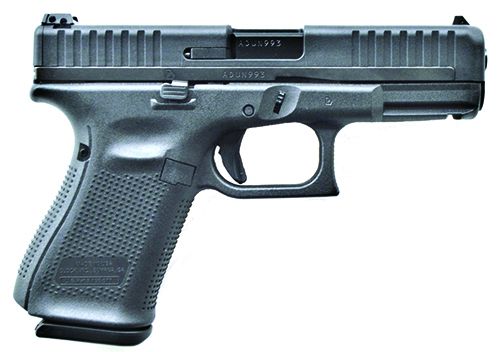
| Action Type | Blowback, Safe Action double action only |
| Overall Length | 7.02 in. |
| Height | 5.04 in. |
| Max Width | 1.2 in. |
| Weight Unloaded | 14.6 oz. |
| Weight Loaded | 16.4 oz. |
| Slide Material | Hybrid, polymer-steel reinforced |
| Slide Retraction Effort | 10.0 lbs. |
| Receiver Material | Polymer |
| Front Strap Height | 2.7 lbs. |
| Back Strap Height | 2.5 lbs. |
| Barrel | 4.01 in. Marksman Barrel |
| Grip Thickness Max | 1.25 in. |
| Grip Circumference | 5.6 in. |
| Magazines | (2) 10 round |
| Rear Sight | Adjustable Glock polymer, white outline |
| Front Sight | Post front, white dot |
| Sight Radius | 6.0 in. |
| Trigger Pull Weight | 5.8 lbs. |
| Trigger Span | 2.8 |
| Trigger Travel/Reset Travel | 0.27 in., 0.7 in. |
| Safety | Trigger lever |
| Warranty | Limited lifetime |
| Made In | USA |
| Telephone | (770) 432-1202 |
| Website | US.GLOCK.com |
This turned out to be the least reliable handgun we have tested from a maker famed for reliability. The Glock 44 is a Glock 19-size handgun. The primary innovation of the Glock 44 is a “hybrid metal” slide. It is a mix of polymer reinforced with steel. No worries, steel is in the right place for strength. The pistol is identical in dimension to the Glock 19, a good size for a rimfire pistol. The locking block is different, and so is the barrel. The Glock 44 is supplied with the same type of frame inserts as the Glock 19 to ensure good handfit.
The Glock 44 features a 4.02-inch barrel and an overall length of 7.02 inches. After trying it in a half-dozen holsters in both leather and Kydex, the Glock 44 seems to fit Glock 19 holsters well. We used a JMCustomKydex.com Road Dog holster for most of the test. This holster offers a good mix of speed and retention. Holster compatibility allows draw and shoot practice with the Glock 44 if you own a Glock 19. This is a real advantage of the 22 version of a centerfire handgun. You just don’t get that kind of utility with a Ruger Standard Model or Browning Buckmark. The Glock 44 handles exactly like a Glock 19. The Glock 44 features a Glock Marksman barrel with fluted chamber. Unlike most other 22-caliber rimfire handguns, the Glock 44 may be dry-fired.
The Glock 44 differs significantly in weight compared to the Glock 19. At just over 14.5 ounces, the Glock 44 weighs less than the 23.5-ounce Glock 19 9mm. A significant difference is that the Glock 44 uses a 10-shot magazine. The magazine is designed to be an easy-load style and features an easily grasped follower spring depressor. The waffle-backed Glock-style magazine is designed for feed reliability over capacity, and it seems to accomplish the former goal.
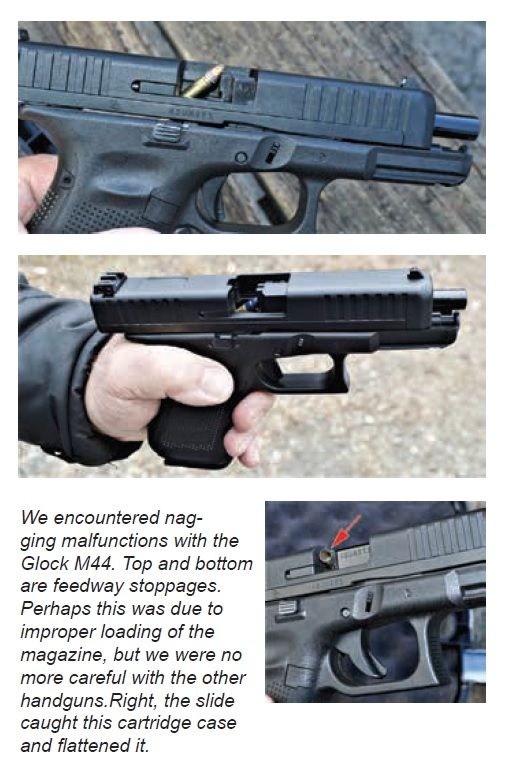
The pistol isn’t a fixed-barrel straight-blowback system, but rather incorporates a separate barrel. The Glock 44 disassembles in the traditional Glock manner. There are no departures from standard Glock operation and manipulation. The magazine release, slide locks, and take down are identical to other Glock pistols. The pistol features a Generation 4 grip with finger grooves on the front strap. The Glock 44 features the standard white-outline Glock sights. The rear sight is a variation on the Glock adjustable sight seen on the original Glock 17L and other handguns. An adjustment tool is included. The pistol features well-designed cocking serrations both front and rear, and the light rail is Glock standard.
The rimmed 22 Long Rifle cartridge feeds best in a single-column magazine. Primary concerns in designing a 22 rimfire handgun and magazine are the problems of a rimmed cartridge case, heel-based bullet, and sometimes dirty powder. We have noted in recent months that rimfire ammunition seems more reliable than ever, which is encouraging. There are still problematic, even finicky, 22-caliber handguns. The Glock 44 is not one of these. Just the same, it isn’t as reliable as it has been touted to be by some. In short, it was the least reliable of the three pistols, although it ran 100% with some loads.
Fired offhand, the lightweight pistol is Glock-like in handling. The 5.8-pound trigger is smooth and tight like a Glock. The Glock trigger has a certain amount of take up and then a wall, which the shooter breaks the trigger against. The lighter slide doesn’t allow as much of a balance against trigger-pull weight as a center-fire Glock, and some shooters may have a problem with this. It requires acclimation. All raters enjoyed firing the pistol, and we busily loaded magazines as we traded the pistol back and forth. We purchased a third magazine for $28 retail. It isn’t a fault of the handgun, but one drawback in training surfaced when firing at steel gongs at 15 yards. We saw little movement of the gongs and got little audio feedback. The 22 doesn’t have enough momentum to move targets that are sprung for the 9mm. When firing the Ruger LCP II, which developed even less velocity, we taped the gongs over as a reference and then checked for hits as we would a conventional paper target.
During the first part of the firing test of 700 high-velocity cartridges, there were a number of failures to feed, chamber, fire, and eject the Remington Thunderbolts. The first half-dozen failures were failures to feed the first shot. It took some experimentation to align the first round in the magazine properly for feeding. Occasionally, a spent case was caught between the slide and the chamber. All of these occurred during the first 200 cartridges. Then we had 200 trouble-free rounds after a modest break in and solving the first round feed angle problem. But then the Glock occasionally tied up, perhaps at a 5% rate, after becoming dirty at about 420 rounds. After burning up the Thunderbolts, we moved to other types. The Winchester M22 was uneventful. The first cartridge of the Winchester Super-X misfed twice. The CCI subsonic generally functioned; however, we did see failures to hold the slide open on the last shot and a couple of short cycles. The CCI Mini Mag, fired at the end of the test in the dirty gun, sailed through without a single failure to feed, chamber, fire, or eject.
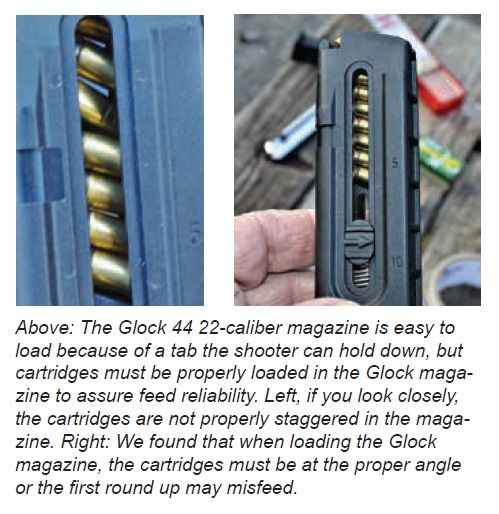
In some cases, we believe the shooter may have been at fault. The Glock M44 rimfire demands that cartridges be carefully stacked in the magazine, not simply dropped in as you hold the follower down, and the angle of the first cartridge to feed is important. Once the first cartridge fed, the rest were likely to. At one point we noticed a staggered off-center cartridge about five cartridges down before we began firing and fixed it. These are wide magazines that fit into a Glock 19 frame designed for high-capacity 9mm magazines. The other 22-caliber pistols use slim magazines. We were glad the Glock is supplied with two magazines, but we really would have liked to have two more during the range work.
The pistol handles well with minimum recoil. It could be an able trainer for those deploying a Glock centerfire for personal defense. The pistol is also a viable trainer for young persons or anyone wishing to learn to use a handgun. Because the sights may be changed for any number of aftermarket types, compatibility with Glock pistols is excellent, we thought. When discussing the addition of night sights to the Glock 44, one maker advised they do not recommend their iron sights be shoehorned into the polymer hybrid slide. Time will tell.
After the troubling initial malfunctions and then a long period without any type of tie up, we were really enjoying the Glock M44. We discussed cleaning the pistol, but instead doused it with lubricant to make a 1,000-round test of reliability. On the benchrest, we used three loads. The pistol proved accurate enough for most any use a 22 will be put to. With groups of 1.45 to 2.0 inches at 15 yards, the Glock was the most accurate of the three handguns. While it is also the largest handgun, this was good performance.
Our Team Said: We find the Glock 44 to be a good trainer and is also useful as a field gun for small-game hunting or clearing away pests and rodents. The 22 LR is low on the list for personal defense, but if you cannot tolerate recoil or this is what is on hand, you are far from helpless. But be certain that the pistol is reliable with a specific load that you choose. Downside: It had nagging malfunctions that would have failed a personal-defense handgun.
Ruger LCP II Lite Rack 13705 22 LR, $299
GUN TESTS GRADE: B
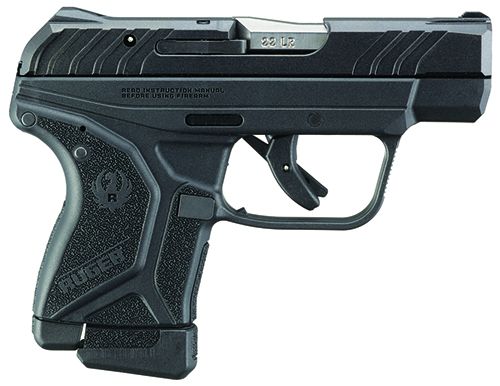
| Action Type | Blowback, Safe Action double action only |
| Action Type | Blowback, single action |
| Overall Length | 5.02 in. |
| Height | 3.8 in. |
| Max Width | 0.85 in. |
| Weight Unloaded | 11.2 oz. |
| Weight Loaded | 13.97 oz. |
| Slide Material | Alloy Steel |
| Slide Retraction Effort | 8.0 lbs. |
| Receiver Material | Glass-filled nylon |
| Front Strap Height | 1.25 in. |
| Back Strap Height | 2.0 in. |
| Barrel | 2.75 in. |
| Grip Thickness Max | 0.8 in. |
| Grip Circumference | 4.5 in. |
| Magazines | (1) 10 round |
| Rear Sight | Fixed notch |
| Front Sight | Post front |
| Sight Radius | 4.1 in. |
| Trigger Pull Weight | 5.6 lbs. |
| Trigger Span | 2.5 in. |
| Trigger Travel/Reset Travel | 0.25 in., 0.5 in. |
| Safeties | Manual lever, trigger lever, magazine disconnect |
| Warranty | None written |
| Made In | USA |
| Telephone | (336) 949-5200 |
| Website | Ruger.com |
The grip design and forward cocking serrations are each well designed and effective. The barrel doesn’t recoil with the slide, but it tilts a bit as the handgun recoils and the cartridge loads into the chamber. The recoil spring is tiny. One rater likened it to a ballpoint-pen spring. There is nothing to be desired in handling the pistol, despite its small size. The slide is easy to rack, and there are two small protrusions on the rear of the slide to aid in cocking. This is a modern feature found on the S&W EZ Rack 9 and other handguns. We found it worked as designed and made for easy racking of the slide.
The safety has an odd-feeling operation at first. The lever doesn’t travel in an arc, but rather presses forward to take the safety off. The safety operates well, and it detents into position in a positive manner. However, it must be taken off Safe as the handgun is brought into action and before the pistol is in a firing position. When the handgun is held in the firing position, the safety would be difficult to manipulate without breaking the firing grip. The safety may be moved to the Safe position by moving the thumb rearward without breaking the firing grip. There is also a magazine safety that prevents the pistol from firing if the magazine isn’t in place. Some find the magazine safety to be a good touch, but we prefer not to have such a safety on a defensive handgun. The LCP II 380 doesn’t have this safety.

The LCP II 22 is supplied with a single 10-round magazine. We ordered another from SCGunco.com for $28. While this drove the price of the pistol up, it is still not an expensive handgun. But adding the magazine to the price brings the total cost of the LCP II with two magazines to $327, $41 more than the S&W. We feel that a pistol should be supplied with two magazines, but then this is a pistol that is found for sale in most shops for $309 or so.
We really like the sights; they are among the best fixed iron sights found on a (very) small handgun. The trigger features a safety-lever insert into the trigger face. Theoretically, the pistol might be carried with this lever as the sole safety, but we prefer a manual safety. This pistol is likely to be carried in a pocket, not in a belt holster. We began all firing tests with the action set to Safe.
At the range, we fired the Ruger LCP II 22 with the same loads as the other handguns. The LCP II isn’t a hard-kicking handgun by any means, but at only 11.2 ounces, it is the lightest handgun tested. There is some rearward momentum as the pistol fires. As we neared the end of the 500 Remington cartridges, the raters noted it was tiring to finish the firing program. It is perhaps unusual to fire a brick of 22s in less than an hour, but then that is what we do. The other pistols, larger guns, were largely indistinguishable in recoil. Even though the S&W is dimensionally more compact than the Glock, it weighs about an ounce more. The LCP II was a bit whippy after a few hundred rounds. But the LCP II is designed as a rimfire training counterpoint/understudy for the LCP II 380 ACP. In this regard, it works very well. Incidentally, it weighs slightly more than the centerfire LCP II.
During the firing, the LCP II Lite Rack lived up to its name. The slide is very easy to rack. The firing grip isn’t as good as we got with the larger handguns. This would matter more with a centerfire, but we still found that crunching the hand around such a small pistol sometimes resulted in the firing-hand thumb bumping into the slide lock. On at least a half dozen occasions, shooters allowed the support-hand thumb or firing-hand thumb to bump into the slide lock, locking the slide open. The thumb quickly moves to drop the slide when this occurred. We adopted an offset and thumbs forward attitude to cure the problem. We cannot call this 100% shooter error, so we nicked the gun on the slide-lock design. This is probably why the original LCP wasn’t designed with a slide lock.
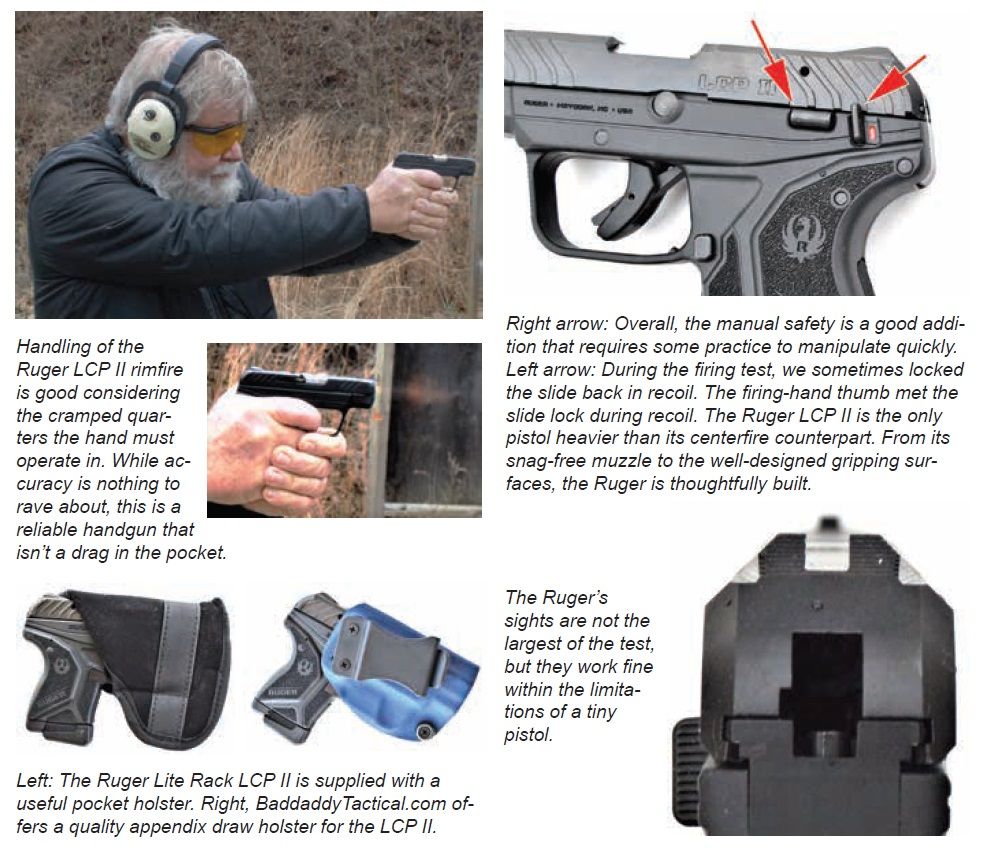
During the firing tests, there were several occasions, eight to ten, when the slide failed to lock open on the last shot, primarily with the subsonic loads but also at least twice with high-velocity loads. We do not think this was shooter related. In firing a total of 1000 cartridges, the Ruger LCP II demonstrated a high level of reliability. The thumb-in-the-slide-lock problem may be addressed with training. The failure to lock open on the last shot with subsonic ammunition is not a demerit because subsonic ammunition isn’t rated for this pistol.
The magazines were the least popular of the three pistols. Although they hold as many rounds as the other two pistols, and that is a neat trick in such a small handgun, the Ruger LCP II 22 magazines have sharper feed lips and are more difficult to load. Perhaps there wasn’t enough room to include an easy-load feature in such a light handgun. The pistol is supplied with a useful magazine loader.
As for absolute accuracy, this isn’t a handgun well suited to 25-yard testing. At 15 yards, the pistol grouped five shots into 2.8- to 4.7-inch groups, which we think is acceptable. The 7.1-pound trigger worked well and broke cleanly.
Our Team Said: The pistol is a good-handling handgun for its size, and the demerits — the slide-lock problem and the difficulty in loading the small magazines — are related to the pistol’s size. The pistol exhibited good performance in firing quickly at man-sized targets. It is accurate enough to take out a reptile at a few yards. Unlike the other two handguns, it doesn’t have great utility for hunting. On the other hand, it is a compact 10-shot 22 that is reliable with some loads. We have never tested a handgun this small we liked so much.
Smith & Wesson M&P22 Compact 22 LR, $286
GUN TESTS GRADE: A (OUR PICK)
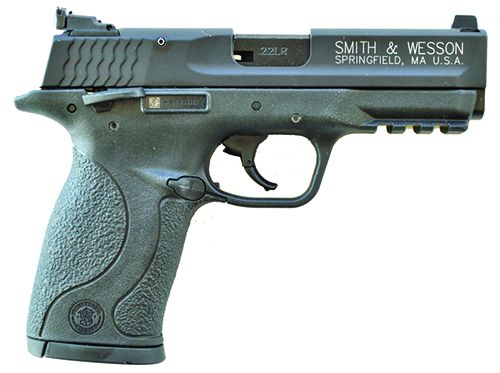
| Action Type | Blowback, single action |
| Overall Length | 6.7 in. |
| Height | 4.8 in. |
| Max Width | 1.2 in. |
| Weight Unloaded | 15.3 oz. |
| Weight Loaded | 17.1 oz. |
| Slide Material | Aluminum |
| Slide Retraction Effort | 9.5 lbs. |
| Receiver Material | Polymer |
| Front Strap Height | 2.3 in. |
| Back Strap Height | 3.25 in. |
| Barrel | 3.6 in. |
| Grip Thickness Max | 0.9 in. |
| Grip Circumference | 5.15 in. |
| Magazines | (2) 10 round |
| Rear Sight | Adj. windage and elevation, white dot insert |
| Front Sight | Post with white dot |
| Sight Radius | 5.4 in. |
| Trigger Pull Weight | 7.6 lbs. |
| Trigger Span | 2.55 in. |
| Trigger Travel/Reset Travel | 0.24 in., 0.5 in. |
| Safety | Manual Safety/Trigger Lever/Magazine Safety |
| Warranty | Lifetime |
| Made In | USA |
| Telephone | (800) 331-0852 |
| Website | Smith-Wesson.com |
The barrel is fixed. We liked the takedown; twist a lever and pull the slide back and up. The S&W is finished in a nice, dark anodizing on aluminum slide, and the frame is black polymer. The safety is ambidextrous. The slide lock is left hand only. The M&P22 features an adjustable rear sight. The pistol features a light rail that allows mounting modern lights and lasers. The rear sight was rated the top sight of the test by all raters, with one comparing the sights to the legendary Bo-Mar brand in efficiency. The sight appears more robust than the plastic Glock sights. The front post is a good design for accuracy. The slide is reasonably easy to rack, and the grip was rated the best of the test. While the shooter might feel a slim-line 9mm recoil more with such a thin grip, the size was deemed nearly ideal for most hands. A sore spot was the trigger action. The trigger breaks at 7.6 pounds, heaviest of the test. Despite this, we were able to do good work on targets.
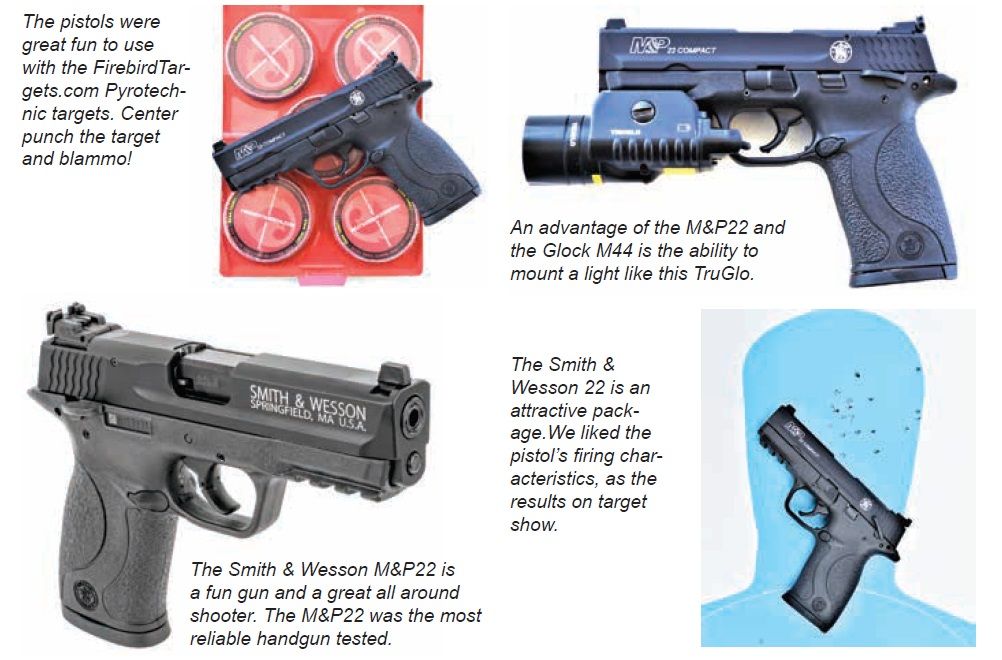
During the combat-style phase, we included firing at pine cones, dirt clumps on the berm, and other small targets. The pistol proved fast handling and came on target quickly. The safety is positive in operation, and the trigger, while heavy, is smooth and breaks clean. The pistol was controllable and accurate and produced good, tight groups on paper and wasn’t difficult to use on small targets at known and unknown distances. A counterpoint to the performance of both the Glock and the Ruger rimfire handguns came when the final of the initial 700 cartridges were fired. There were no gun-related malfunctions. The pistol never failed to chamber, fire, or eject. There was a single failure to fire. The cartridge had a good indent on the case rim. We wrote this off to the vagaries of rimfire production. The CCI subsonic cracked off when we re-chambered it, ensuring the firing pin hit a different area of the cartridge-case rim.
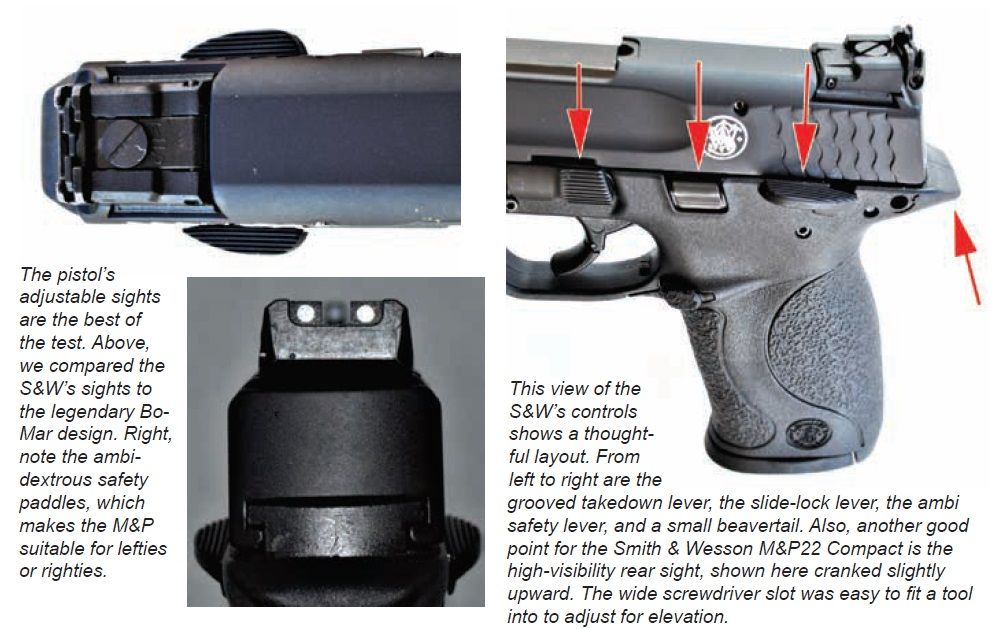
Firing off the benchrest for accuracy, we learned the S&W M&P22 could produce good accuracy. With five-shot groups of 2.0 to 3.3 inches, the pistol is accurate enough for training and informal target practice. A 22 understudy doesn’t need to be much more accurate than its centerfire counterpart, but both the Glock 44 and the S&W 22 are more accurate than their closest 9mm counterparts.
Our Team Said: The pistol is more compact than the Glock and enough larger than the Ruger to improve accuracy. We like the safety system. The sights are excellent. No gun-related malfunctions. Buy this one.

























